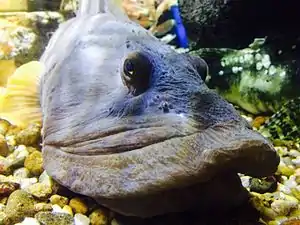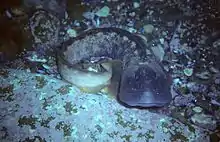Ocean pout
The ocean pout (Zoarces americanus) is an eelpout in the family Zoarcidae. It is found in the Northwest Atlantic Ocean, off the coast of New England and eastern Canada. The fish has antifreeze proteins in its blood, giving it the ability to survive in near-freezing waters.
| Ocean pout | |
|---|---|
 | |
| Ocean pout at the Woods Hole Science Aquarium | |
| Scientific classification | |
| Kingdom: | |
| Phylum: | |
| Class: | |
| Order: | |
| Family: | |
| Genus: | |
| Species: | Z. americanus |
| Binomial name | |
| Zoarces americanus | |

Use in genetic modification
Scientists have succeeded in taking genes from ocean pout and implanted those into Atlantic salmon.[1][2] The promoter for the antifreeze protein gene is used in conjunction with a growth hormone gene from Chinook salmon, which leads to a higher concentration of the growth hormone in the blood, causing the genetically modified salmon to grow much more rapidly. These transgenic salmon reach a harvest weight in two-thirds of the time that it takes their unmodified counterparts. Controversy has arisen, as some view the genetically altered salmon as a potential threat to wild salmon stocks should it escape into the wild. AquaBounty Technologies has attempted to address these concerns by stating that all of the transgenic salmon to be intended for sale will be sterile females. As of late 2017, several tons have been sold in Canada, and final approvals and decisions on labeling are pending in the United States. Some restaurant and grocery store chains in the United States have announced they will not sell the new fish, citing concerns over its safety for human consumption, despite no scientific evidence showing risk.[3]
In June 2006, the Unilever company announced that it would research the potential use of genetically modified yeast to grow antifreeze proteins based on a gene from the ocean pout, and use proteins extracted from the yeast to improve the consistency and storage properties of ice cream. Incorporating these ice-structuring proteins means that a lower cream content, and thus a lower calorie content, ice cream can be manufactured without the risk of ice crystal formation.[4]
References
- Gorman, James (22 September 2002). "Dumb and Dumber: Here's a Fish Story With Legs". The New York Times. Retrieved 20 November 2007.CS1 maint: ref=harv (link)
- Burke, Monte (19 February 2001). "Cannery Roe". Forbes.com. Retrieved 20 November 2007.CS1 maint: ref=harv (link)
- Burros, Marian (18 September 2002). "Chefs Join Campaign Against Altered Fish". The New York Times. Retrieved 20 November 2007.CS1 maint: ref=harv (link)
- Moskin, Julia (26 July 2006). "Can a bit of Arctic pep up ice cream?". The New York Times. Retrieved 23 February 2013.CS1 maint: ref=harv (link)
Further reading
- Killen, S. S.; Brown, J. A.; Gamperal, A. K. (February 2008). "Lack of metabolic thermal compensation during the early life stages of ocean pout Zoarces americanus (Bloch & Schneider): a benthic, cold-water marine species". Journal of Fish Biology. 72 (3): 763–772. doi:10.1111/j.1095-8649.2007.01735.x.
- McAlpine, Donald F. (January 2013). "The Ocean Pout, Zoarces americanus, and the Ocean Sunfish, Mola mola: Additions to the Marine Ichthyofauna of the Lower Saint John River System, New Brunswick, with a Summary of Marine Fish Reported from the Estuary". Canadian Field-Naturalist. 127 (1): 38–43. doi:10.22621/cfn.v127i1.1405.